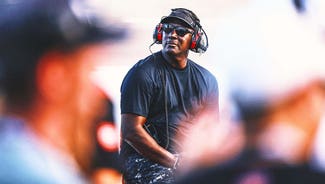
Tires giving drivers worries at M'ville
Tires are a concern for NASCAR drivers this weekend at Martinsville Speedway.
Dale Earnhardt Jr. described the tires as "pretty crappy." He expressed trepidation about the marbles (balls of rubber accumulating off the tires) in the upper lanes of the track which will make it difficult to pass.
“You just won’t want to be in the second groove. If you go into the second groove, if there is marbles there, you don’t want to get them on your tires, they won’t come off.
Earnhardt said. "So, you wouldn’t want to be up there at all.
"After 12 laps, everybody was kind of falling off pretty fast. There was no rubber built up and there was a lot of marbles. You couldn’t get out of the bottom groove. You had to run right next to the curb. If you got in the marbles, it would ruin you. Once you got in the marbles, you ruined that set. I mean, there is no way to get them off. We don’t go fast enough here to really grind them off. It was messy. It was just real messy all day.”
Kyle Busch, who is running both the Camping World Truck and Sprint Cup Series races this weekend said “the grip is gone” after 37 laps in his truck. Busch said the tires on the Cup cars just “felt bad” after 25 laps of practice.
Ryan Newman wasn’t certain the teams would make a complete fuel run before having to change tires on Sunday.
Carl Edwards described the sensation of working with this tire combination and trying to figure it out as “chasing a ghost.” During his qualifying attempt, where he posted the 23rd-fastest lap, Edwards thought he warmed up his tires “a little too much.”
“It’s just so hard to get the tires to go right away,” Edwards said. “I don’t know if it’s the construction, I guess it’s got to be the compound because once they get warmer, they seem to go faster.”
Jeff Gordon admits that every driver wants more grip, but he was struggling with his car being “really bad loose” getting in and off the corners.
“I was just glad that we weren’t alone in that because it was definitely making me nervous with how bad loose the car was getting and that’s something that’s not typical for us here,” Gordon said. “So we were really challenged with that quite a bit and felt like we made gains on it throughout the day.
“Right now we’re trying to anticipate what the tires are going to do, what the rubber is going to do. Is it going to lay down? Is that wear going to get better? You certainly think that it should, but you never know these days.”
But NASCAR Sprint Cup Series director John Darby said, “It’s way too early to be talking about tires.”
“Here's what we know: The tire is different than what it was last year,” Darby said. “The tire's not failing. The tire has some different driveability characteristics that everybody is dealing with.
“But it's a combination of a tougher left side and softer right side. So the cars feel different. It's hard to make a judgment either way right now. We'll see what 500 laps of racing does.”
Darby said that Goodyear went back to the drawing board to construct “a better tire“ particularly given the high degree of heat (1,500 degrees Fahrenheit) that the brakes give off at Martinsville after slowing a 3,400-pound car traveling at 125 mph down to half that speed to manage the hairpin turns. Martinsville ranks second only to Watkins Glen as a track that's taxing on brakes.
But Goodyear officials remain optimistic.
“The big change between this year and last year is we had a lot of graining on our left side tires last year,” said Goodyear’s product manager Rick Heinrich. “To address that we toughened up the left side a little bit and softened up the right sides a little bit to balance out the combination, We’re seeing a lot of wear. The track was a little bit resistant to take rubber yesterday because it was real, real cold and overcast. The wear didn’t go away quite as quickly as what we normally see.
“Now, it’s warmed up a little bit. We didn’t see any practice (Saturday) so the track didn’t have a chance to take on any (rubber). I think once we get past the truck race. we’ll have a nice layer of rubber put down for (the Sprint Cup race).”
Darby is quick to remind that not every tire combination is perfect.
“With the high use of brakes, bead heat is always an issue,” Darby said. “They use so much brakes, we'll see some failure because of the beads melting. Different fabrics, different compositions are used in the casings to try and help that. It would be nice, obviously, if a tire was developed to help the outside lane here to promote more passing and things of that nature.”
Darby acknowledged there was not an official tire test at Martinsville prior to the weekend. The change in the tire “was not significant enough to warrant it in Goodyear’s mind.”
Darby believes that cooler temperatures are contributing to a lack of rubber accumulating on the track.
Matt Kenseth, who qualified 24th on Saturday, was not optimistic.
“If it gets a little bit warmer, that rubber might build up like it usually does here, but it will be interesting to watch the truck race (since) there’s no practice or anything.”
Sprint Cup teams received 11 sets for the race, plus five additional sets for practice and qualifying.

